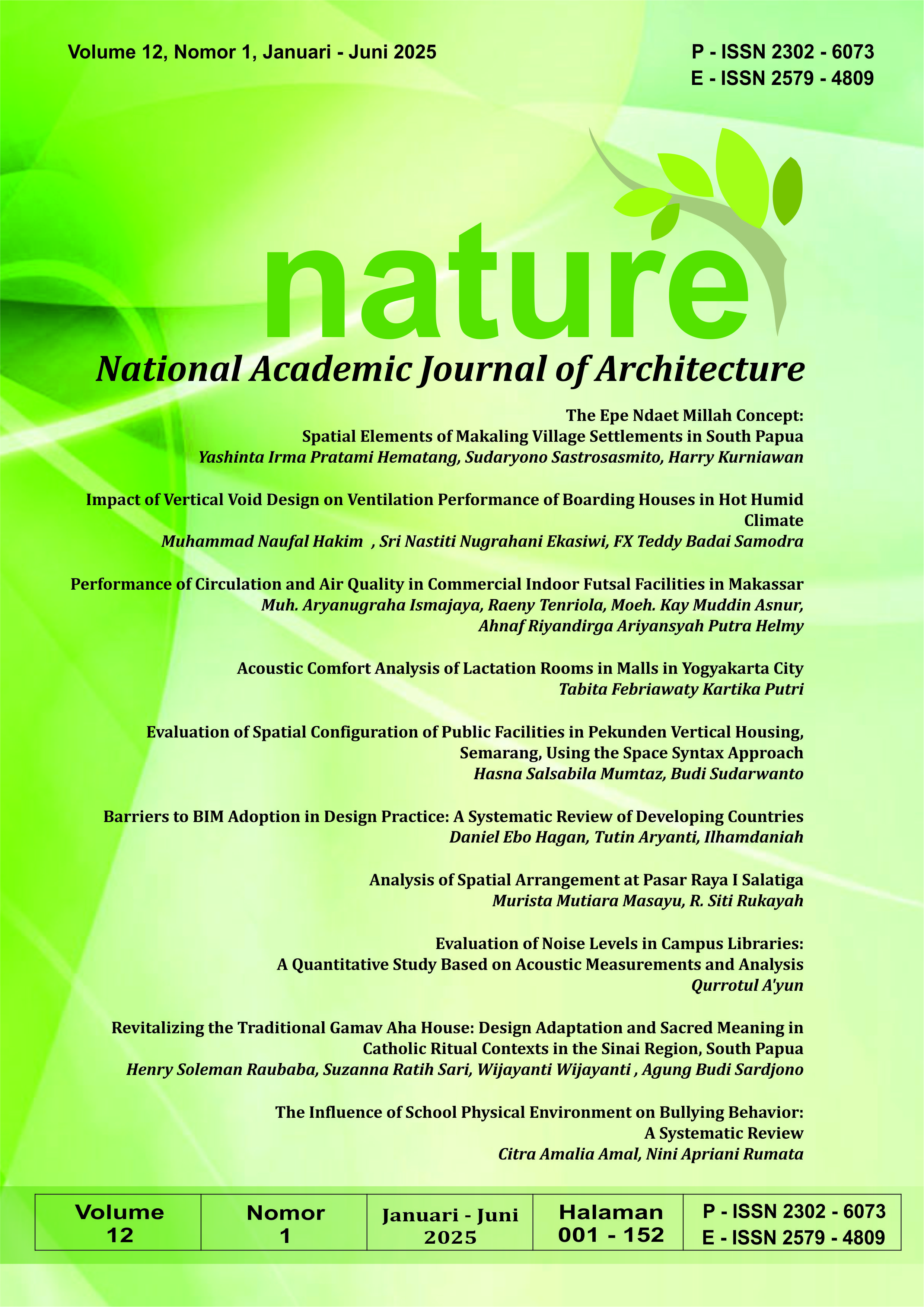Pengaruh Lingkungan Fisik Sekolah Terhadap Perilaku Bullying: Sebuah Tinjauan Sistematis
DOI:
https://doi.org/10.24252/nature.v12i1a10Kata Kunci:
Lingkungan Fisik Sekolah, CPTED, SLR, BullyingAbstrak
Lingkungan fisik sekolah berperan penting dalam membentuk perilaku sosial siswa, termasuk dalam mencegah bullying. Penelitian ini bertujuan mengevaluasi pengaruh desain lingkungan fisik terhadap bullying melalui pendekatan Systematic Literature Review (SLR). Fokus kajian mencakup visibilitas, pengawasan, serta penerapan prinsip Crime Prevention Through Environmental Design (CPTED) dalam desain sekolah. Literatur dikumpulkan dari database seperti ScienceDirect dan Google Scholar, dengan kata kunci “school bullying” pada rentang 2014–2024. Studi yang dipilih merupakan penelitian empiris dalam disiplin ilmu sosial, psikologi, dan kesehatan, yang membahas hubungan desain fisik sekolah dan bullying. Kriteria inklusi mencakup studi yang meneliti desain fisik dengan fokus pada keamanan dan pengawasan, serta dampaknya terhadap pengurangan bullying. Studi non-empiris atau yang tidak relevan dikecualikan. Hasil analisis menunjukkan bahwa prinsip CPTED, seperti peningkatan visibilitas dan pengawasan alami, efektif menurunkan kejadian bullying. Area yang terbuka dan mudah diawasi terbukti lebih aman dibandingkan area tersembunyi. Selain itu, desain yang menunjang kenyamanan siswa turut meningkatkan kesejahteraan psikososial dan mencegah risiko gangguan mental di masa depan. Kajian ini juga menyajikan ilustrasi desain sekolah berbasis CPTED sebagai rekomendasi praktis dalam mendukung kebijakan anti-bullying di lingkungan pendidikan.
Unduhan
Referensi
Abdul Wahab, A., & Md Sakip, S. R. (2019). A cE-Bs2019LangkawiIsland Mapping Isolated Places in School in Concurrence with Bullying Possibility Elements. Environment-Behaviour Proceedings Journal, 4(12), 359. https://doi.org/10.21834/e-bpj.v4i12.1913
Bjereld, Y., Augustine, L., & Thornberg, R. (2020). Measuring the prevalence of peer bullying victimization: Review of studies from Sweden during 1993–2017. Children and Youth Services Review, 119, 105528. https://doi.org/https://doi.org/10.1016/j.childyouth.2020.105528
Faccio, E., Iudici, A., Costa, N., & Belloni, E. (2014). Cyberbullying and Interventions Programs in School and Clinical Setting. Procedia - Social and Behavioral Sciences, 122, 500–505. https://doi.org/https://doi.org/10.1016/j.sbspro.2014.01.1382
Foody, M., Murphy, H., Downes, P., & O’Higgins Norman, J. (2018). Anti-bullying procedures for schools in Ireland: principals’ responses and perceptions. Pastoral Care in Education, 36(2), 126–140. https://doi.org/10.1080/02643944.2018.1453859
Forsberg, C. (2022). The Importance of Being Attentive to Social Processes in School Bullying Research: Adopting a Constructivist Grounded Theory Approach. International Journal of Bullying Prevention, 4(3), 180–189. https://doi.org/10.1007/s42380-022-00132-y
Francis, J., Strobel, N., Trapp, G., Pearce, N., Vaz, S., Christian, H., Runions, K., Martin, K., & Cross, D. (2022). How does the school built environment impact students’ bullying behaviour? A scoping review. Social Science & Medicine, 314, 115451. https://doi.org/https://doi.org/10.1016/j.socscimed.2022.115451
Francis, J., Trapp, G., Pearce, N., Burns, S., & Cross, D. (2022). School Built Environments and Bullying Behaviour: A Conceptual Model Based on Qualitative Interviews. International Journal of Environmental Research and Public Health, 19(23). https://doi.org/10.3390/ijerph192315955
Garibaldi, M., & Josias, L. (2015). Designing schools to Support Socialization Processes of Students. Procedia Manufacturing, 3, 1587–1594. https://doi.org/https://doi.org/10.1016/j.promfg.2015.07.446
Glubwila, S., Sripa, K., & Thummaphan, P. (2022). The model of collaboration integration for preventing and solving the problem of youth violence in educational settings. Current Psychology, 41(12), 8461–8470. https://doi.org/10.1007/s12144-020-01270-6
Gough, D., Thomas, J., & Oliver, S. (2012). Clarifying differences between review designs and methods. Systematic Reviews, 1(1), 28. https://doi.org/10.1186/2046-4053-1-28
Horton, P., Forsberg, C., & Thornberg, R. (2020). “ It ’ s hard to be everywhere ”: Teachers ’ perspectives on spatiality , school design and school bullying. 12(2), 41–55.
Isa, M. L., Lumpur, K., Ibrahim, W. N., Kamil, M., Hasan, C., Nurumal, S., Kamil, M., & Hasan, C. (2021). A Cross-Sectional Study on Bullying and Psychological Disturbances among Malaysian School Children Health Research A Cross-Sectional Study on Bullying and Psychological Disturbances among Malaysian School Children. 25(1). https://doi.org/10.7454/msk.v25i1.1243
Izadi, M., & Hart, R. (2024). The influence of the physical environment on social behavior, school climate, and bullying in schools. Children’s Geographies, 22(1), 66–81. https://doi.org/10.1080/14733285.2023.2232751
Lamoreaux, D. J., & Sulkowski, M. L. (2021). Crime Prevention through Environmental Design in schools: Students’ perceptions of safety and psychological comfort. Psychology in the Schools, 58(3), 475–493. https://doi.org/https://doi.org/10.1002/pits.22459
Liu, Y., & Hu, F. (2021). Being bullied at school as a child, worse health as an adult? Evidence from China. International Journal of Educational Development, 82(C,), S0738059321000274.
Md Sakip, S. R., & Abdul Wahab, A. (2020). Bullying in School: Evaluation using CPTED at potential bullying area. Environment-Behaviour Proceedings Journal, 5(SI2), 3–13. https://doi.org/10.21834/ebpj.v5isi2.2520
Migliaccio, T., Raskauskas, J., & Schmidtlein, M. (2017). Mapping the landscapes of bullying. Learning Environments Research, 20(3), 365–382. https://doi.org/10.1007/s10984-017-9229-x
Pauzi, N., Ghazali, S. R., Chen, Y. Y., Majani, A. F., Adenan, F., & Manogaran, K. (2023). School-Aged Bullying History, Post-Traumatic Stress Disorder (PTSD), and Depressive Symptoms: A Study of University Students in Malaysia. Asia-Pacific Social Science Review, 23(3), 1–11. https://doi.org/10.59588/2350-8329.1503
Pengpid, S., & Peltzer, K. (2019). Bullying victimization and externalizing and internalizing symptoms among in-school adolescents from five ASEAN countries. Children and Youth Services Review, 106, 104473. https://doi.org/https://doi.org/10.1016/j.childyouth.2019.104473
Romera, E. M., Carmona-Rojas, M., Ortega-Ruiz, R., & Camacho, A. (2022). Bidirectional association between normative adjustment and bullying perpetration in adolescence: A prospective longitudinal study. Revista de Psicodidáctica (English Ed.), 27(2), 132–140. https://doi.org/https://doi.org/10.1016/j.psicoe.2022.03.001
Sabramani, V., Idris, I. B., Ismail, H., Nadarajaw, T., Zakaria, E., & Kamaluddin, M. R. (2021). Bullying and Its Associated Individual, Peer, Family and School Factors: Evidence from Malaysian National Secondary School Students. International Journal of Environmental Research and Public Health, 18(13). https://doi.org/10.3390/ijerph18137208
Silva, G. R. R. e, Lima, M. L. C. de, Acioli, R. M. L., & Barreira, A. K. (2020). Prevalence and factors associated with bullying: differences between the roles of bullies and victims of bullying. Jornal de Pediatria, 96(6), 693–701. https://doi.org/https://doi.org/10.1016/j.jped.2019.09.005
Sittichai, R., & Smith, P. K. (2015). Bullying in South-East Asian countries: A review. Aggression and Violent Behavior, 23, 22–35. https://doi.org/10.1016/j.avb.2015.06.002
Suhartono, E., Jakarta, A., & Cipta, T. (2017). Systematic Literatur Review (Slr): Metode, Manfaat, dan Tantangan Learning Analytics Dengan Metode Data Mining Di Dunia Pendidikan Tinggi. Infokam.
Tilindiene, I., Sukys, S., Zuoza, A., & Alekrinskis, A. (2021). Examining the Relations among Extraversion, Neuroticism, and School Bullying among Lithuanian Adolescents. European Journal of Contemporary Education, 10(2), 476–484. https://doi.org/10.13187/ejced.2021.2.476
Wahab, A. A., Sakip, S. R. M., & Zainol, H. (2018). An Assessment of CPTED Principles in Relation to Bullying Behaviour. Advances in Applied Sociology, 08(01), 25–48. https://doi.org/10.4236/aasoci.2018.81002
Unduhan
Diterbitkan
Cara Mengutip
Terbitan
Bagian
Lisensi
Hak Cipta (c) 2025 Citra Amalia Amal, Nini Apriani Rumata

Artikel ini berlisensiCreative Commons Attribution-ShareAlike 4.0 International License.
By submitting your manuscript to our journal, you are following Copyright and License






















